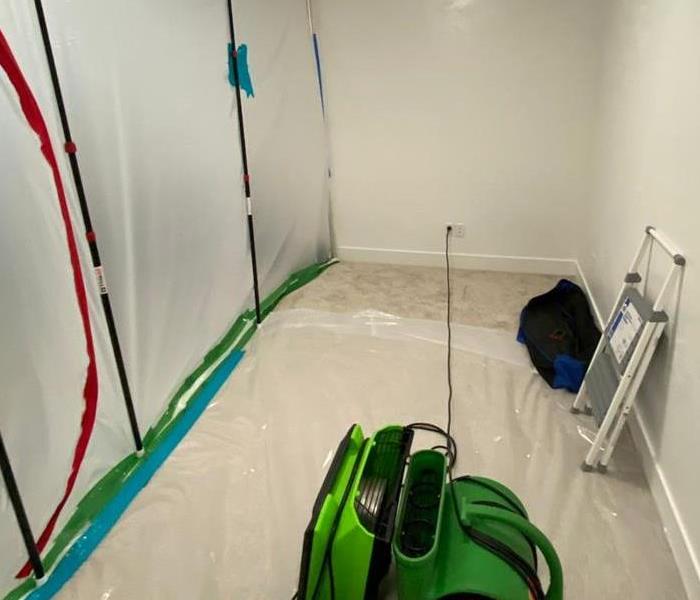Winter Preparation: Protect Your Home from Water Damage and Mold Growth
10/1/2024 (Permalink)
 Our team set up containment to isolate affected areas during water damage restoration. Keeping your home safe and secure throughout the process!
Our team set up containment to isolate affected areas during water damage restoration. Keeping your home safe and secure throughout the process!
As the winter months approach, homeowners in Rexburg and Rigby need to prepare for the challenges that colder weather can bring. Snow, ice, and freezing temperatures increase the risk of water intrusion, which can lead to mold growth if not addressed properly. At SERVPRO of Rexburg/Rigby, we know that winterizing your home is key to preventing water and mold damage. By taking action before the season is in full swing, you can avoid costly repairs and protect the health of your home. Here’s how you can get your home winter-ready.
1. Clean and Maintain Gutters
Why it matters: During the fall, gutters fill up with leaves, twigs, and other debris. Blocked gutters can cause water to overflow, leading to foundation damage, basement flooding, or leaks in your roof, which can create ideal conditions for mold to grow.
Our Advice:
- Clear out your gutters before winter arrives.
- Check for any damage or sagging that may affect water drainage.
- Make sure downspouts are directed at least five feet away from your foundation to prevent water pooling near your home.
2. Inspect Your Roof for Leaks
Why it matters: The winter months often bring heavy snowfall and ice buildup, which can exacerbate small leaks or create new ones. Water leaking into your attic or ceiling can easily lead to mold growth, especially if left unchecked.
Our Advice:
- Inspect your roof for damaged, loose, or missing shingles.
- Check for signs of water stains or mold in your attic.
- Consider installing heat cables or roof rakes to prevent ice dams from forming, which can cause water to back up under shingles.
3. Seal Windows and Doors
Why it matters: Cold air and moisture can sneak into your home through poorly sealed windows and doors, raising the risk of condensation buildup. Over time, this moisture can damage wood frames, walls, and insulation, creating an environment where mold thrives.
Our Advice:
- Apply weatherstripping or caulking around windows and doors to close any gaps.
- Check for drafts by running your hand around the edges of windows and doors.
- Install storm windows or invest in energy-efficient windows to further reduce the chance of moisture entering your home.
4. Insulate and Protect Pipes
Why it matters: Frozen pipes are one of the most common causes of water damage during the winter months. If a pipe freezes and bursts, it can flood your home, causing water damage and creating the perfect conditions for mold to take hold.
Our Advice:
- Insulate exposed pipes, especially those in unheated areas like basements, garages, and crawl spaces.
- Keep your home heated to at least 55°F, even if you’re away.
- Turn off outdoor faucets and drain hoses to prevent freezing.
5. Basement Waterproofing
Why it matters: During winter, snow and ice can melt around your foundation, causing water to seep into your basement. This excess moisture can lead to mold growth if not properly addressed.
Our Advice:
- Check your basement for any existing water damage or mold growth.
- Ensure that your sump pump is working properly and install a backup battery system in case of a power outage.
- Consider sealing any cracks in your foundation to prevent water from entering.
6. Monitor Indoor Humidity Levels
Why it matters: Mold thrives in damp, humid environments, and indoor humidity can rise during winter due to the increased use of heating systems and poor ventilation.
Our Advice:
- Use a dehumidifier in high-moisture areas like basements, bathrooms, and laundry rooms.
- Keep indoor humidity levels below 50%.
- Ensure proper ventilation in areas like kitchens and bathrooms by using exhaust fans.
7. Inspect Attic Insulation and Ventilation
Why it matters: A poorly insulated attic can lead to condensation and ice dams, which may cause water leaks and, eventually, mold growth.
Our Advice:
- Check for adequate attic insulation to prevent heat from escaping and causing snow on your roof to melt unevenly.
- Make sure your attic is properly ventilated to allow moisture to escape.
- Inspect your attic for any signs of mold or water damage and address them immediately.
Stay Prepared, Stay Protected
Water damage and mold growth can quickly turn into a serious issue, especially during the winter months. At SERVPRO of Rexburg/Rigby, we understand the importance of proactive preparation to prevent these problems from arising. By cleaning gutters, inspecting your roof, sealing windows, and properly insulating your pipes, you can significantly reduce the risk of winter water damage and mold.
However, if disaster strikes, our certified team of water and mold restoration experts is here to help. We’re available 24/7 to respond to emergencies and make it "Like it never even happened." Whether you need mold remediation, water extraction, or repairs due to water damage, SERVPRO of Rexburg/Rigby has the tools, expertise, and experience to restore your home to its pre-damage condition.





 24/7 Emergency Service
24/7 Emergency Service